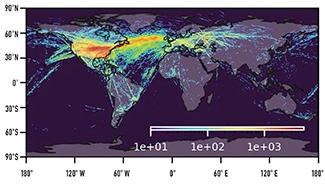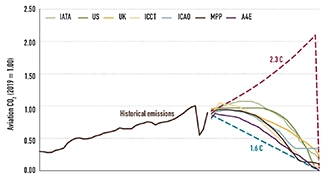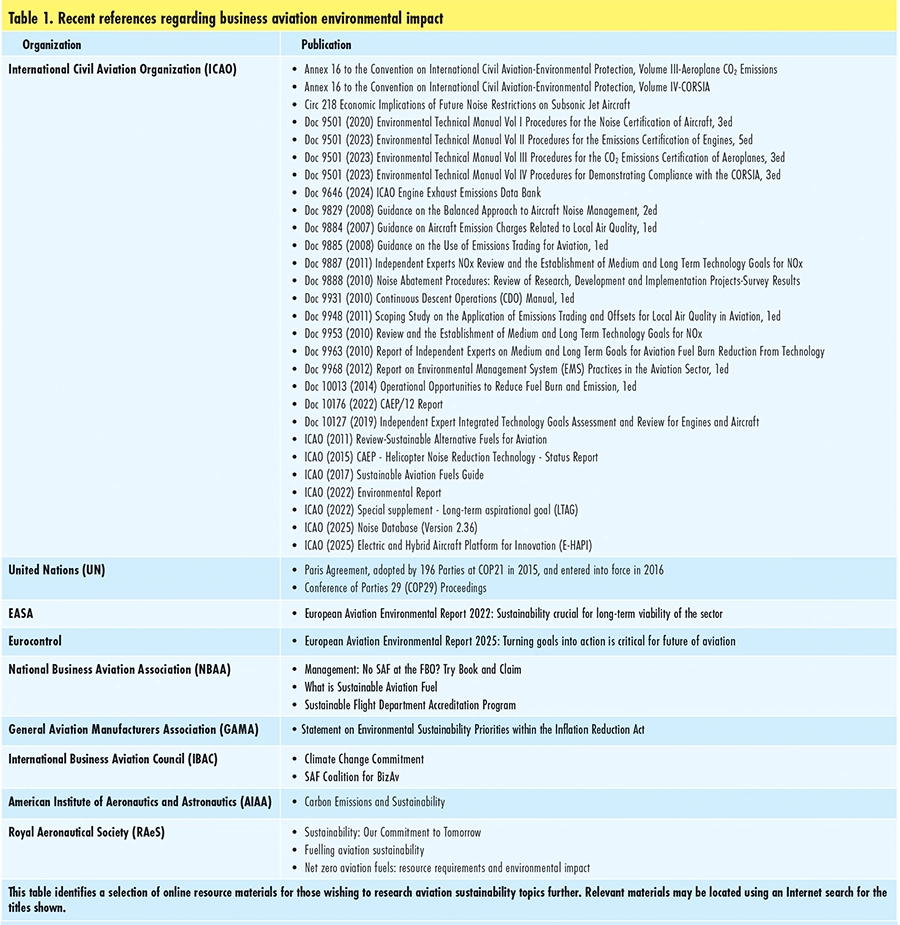Sustainability and the future of business aviation
Bizav’s efforts will help to achieve environmental goals.
By Don Van Dyke
ATP/Helo/CFII. F28, Bell 222
Pro Pilot Canada Technical Editor

Business aviation is a part of general aviation that focuses on the business use of airplanes and helicopters. It seeks to provide safe, secure, and reliable air transport economically with minimal impact on our environment.
Economic and environmental impacts
Business aviation represents more than 1.7 million manufacturing and service jobs (1.2 million in the US alone) and contributes more than $276 billion to the worldwide economy annually. This figure includes direct contributions from OEMs, operators, and support services, as well as indirect and induced impacts resulting from supply chain spending and expenditures by industry employees.
The International Civil Aviation Organization (ICAO) estimates that there are approximately 200,000 general aviation aircraft currently in service globally, including 25,000 jets, helicopters, and turboprops. Approximately 60% of the global fleet is based in the US. This level of activity has considerable associated environmental impact.
The US is currently the world’s second largest greenhouse gas (GHG) emitter. Only China surpasses US emissions. The world is now on pace for global warming of more than 3 °C by the end of the century, according to a recent United Nations (UN) report.
The average age of general and business aviation aircraft is 20–25 years. Older aircraft designs are likely less aerodynamically and/or fuel efficient than newer designs. Only 30% of the current global fleet is at the latest technology standard.
Carbon dioxide (CO2) impact. Data from 2019 shows that aviation, including business aviation, contributes more than 900 million metric tons (2.5%) to GHG emissions annually, largely comprising CO2, mainly through burning fossil fuels.
Non-CO2 impact. Emission of nitrogen oxide (NOx), methane (NH4), and particulate matter by aviation contributes to GHG pollution. While efforts to minimize environmental impact have historically been focused on CO2 emissions, the significant climate impact of warming contrails not offset by the smaller number of cooling contrails, is increasingly of interest.
Noise pollution. Noise pollution is generated by aircraft during takeoff, flight, and landing, particularly near airports and residential communities. However, advances in aircraft technology have led to quieter engines and improved noise designs.

Environmental goals
Net-zero involves offsetting CO2 emissions with their removal (carbon sink) targeting achievement of a net-zero balance to hold global warming under 2 °C, as agreed at the UN Climate Change Conference (COP21) held in Paris in 2015. The long-term aspirational goal (LTAG) target date of 2050 was adopted at the 41st ICAO Assembly in 2022.
This agreement represents a shift away from previous ICAO climate governance. It favors action to reduce CO2 from airplanes and fuels directly, rather than mitigating emissions through the purchase of related credits or offsets from other sectors.
The Sustainable Skies World Summit 2024 confirmed that aviation is failing to progress at a rate needed to reach net-zero by 2050.
Aviation emissions are now 5% above pre-Covid-19 levels, and delays to delivery of new, more efficient aircraft are causing 2–3% of current emissions.
Strategies to achieve climate goals
Currently, the principal strategies employed by business aviation to achieve and ensure sustainability include compliance with related regulatory frameworks, integrating sustainability concepts throughout their operation, and engaging staff internally (and communities externally) on social and environmental responsibility.
Achievement of environment goals requires ongoing refinement of definitions, strategies, and innovations in the following focus areas:

Carbon removals. Carbon removals are expected to be approved this year into the ICAO Carbon Offsetting and Reduction Scheme for International Aviation (CORSIA), and to be made part of governance, instead of relying on voluntary actions, from 2027 onwards.
Efficient flight dispatch. Empty legs (flights without passengers) can be minimized through better scheduling and coordination, considering crew scheduling, maintenance, repair, and overhaul (MRO) aspects, system capacity, and client needs.
Optimized operations. Close collaboration involving flight dispatchers, air traffic controllers, and pilots in coordinating flight schedules, routes, and altitudes will reduce significantly fuel consumption and emissions.
MRO requirements and client needs must be harmonized to avoid empty legs and their environmental consequences.
Collaborative airspace management. The use of real-time data and advanced algorithms to manage air traffic latency can minimize environmental impact. Contrails, for example, contribute to atmospheric warming, and contrail-avoidance strategies to avoid contrail-prone areas can help reduce this impact. This will likely require close collaboration between flight dispatchers, air traffic controllers, and pilots.
Sustainable fuels. Derived from sustainable feedstocks, including cellulosic biomass, food wastes and residues, waste steel mill gases, and captured CO2, sustainable aviation fuel (SAF) is a low-carbon synthetic jet fuel that can be used safely in any turbine-powered aircraft. Promotion and use of SAF is a cornerstone of decarbonization strategies, and is forecast to play a dominant role in aviation’s quest for carbon neutrality by 2050.
Experts note that the biggest problem in SAF production is sourcing sustainable quantities of lipids – a diverse group of organic compounds, including fats, oils, and cholesterol.
SAF is often transported to a specific airport from a remotely located production facility, leading to additional GHG emissions and costs.
Book-and-claim programs offered by FBOs and fuel suppliers make it possible for operators – including those in business aviation – to purchase SAF even when it is not physically available on site.
The National Business Aviation Association (NBAA) Environmental & Technical Operations Dept confirms that the process allows business aircraft operators to offset their use of fossil-based fuel. NBAA also offers a Sustainable Flight Department Accreditation Program to advance a sustainability culture in business aviation.
The International Business Aviation Council (IBAC) also endorses the 2050 net-zero target, encouraging the adoption of innovative technologies, increasing fuel efficiency, and supporting the use of SAF.
Innovation

Aircraft and engines. Newer aircraft and engine designs seek to be more fuel-efficient and produce less noise than their predecessors.
Airbus aims to bring a narrowbody (100-seat), hydrogen-fueled aircraft to market around 2035. More cautiously, Boeing forecasts that hydrogen will not play a major role in decarbonization by 2050.
ICAO monitors possible environmental issues from the operation of Emerging Technology Aircraft (ETA), including noise aspects of urban air mobility concepts, unmanned aircraft, and remotely-piloted aircraft. ICAO also maintains the Electric and Hybrid Aircraft Platform for Innovation (E-HAPI), a publicly available website that provides a non-extensive list of ongoing projects that have been identified globally.
Intelligent and sustainable hangar. The Royal Aeronautical Society (RAeS) Air Transport Conference for the Sustainable Hangar of the Future for 2050 highlighted advanced working practices, decarbonization, efficiency, green energy, and SAF attempts and technical operations including.
The hangar of the future is founded on data-driven, automated inspection technologies developed using data for machine-learning and decision-making. This complete diagnostics system would reduce both operating costs and risks to maintenance personnel, ultimately to achieve zero unscheduled maintenance.
Sustainability will result from the use of hydrogen-powered ground vehicles as a stepping stone to develop wider hydrogen-powered infrastructure and applications.
Digital twinning. Aviation’s drive toward sustainability also adopts digital twins as tools to speed innovation of new aircraft types and propulsion systems. Technologies (eg, hydrogen fuel cells and engines, distributed electric propulsion) seek to avoid years of physical test data for qualification. Virtualization can identify which physical tests remain necessary to achieve certification.
Honeywell recently demonstrated its ability to upgrade efficiently the current cooling capacity of the Lockheed Martin F-35 Lightning II Power and Thermal Management System (PTMS). A digital twin was used to combine data from many hours of testing and in-flight experience and controls to optimize system performance, avoiding the risks otherwise accompanying qualifying and fielding a new system that costs billions of dollars without any additional benefit.
Digital twins in aviation represent a radical change in how the industry approaches the design, manufacture, analysis, operation, and maintenance of aircraft.
The technology provides real-time, in-depth understanding of aircraft behavior and related processes, creating opportunities for predictive collaboration to improve safety, reliability, efficiency, and economic returns.
This leads to more informed decision-making and improved operational performance while minimizing environmental impact. While not itself an MRO, consulting firm McKinsey
& Company has reported on extensive research and surveys on how artificial intelligence (AI-)powered digital twins can revolutionize aircraft MRO and associated environmental concerns.
Energy sources. Development of energy sources for aviation continues at a rapid pace. ICAO monitors these advances closely to prepare for their timely environmental certification.
International collaboration
The landmark Paris Agreement under the UN Framework Convention on Climate Change was adopted by 196 parties at the UN Climate Change Conference (COP21) in 2015, and entered into force in 2016.
The recently announced US withdrawal from the Paris Agreement (for the second time) may have several significant consequences. As the second largest emitter of GHG, the US withdrawal may weaken international efforts to reduce emissions and transition to renewable energy sources.
Economic impact. The US may lose its competitive edge in the race to produce clean energy. Other nations, like China and those of the European Union, may gain a competitive advantage in developing emission-free power and clean energy technology.
Climate policy rollback. The withdrawal signals a broader agenda to undo US climate policies, including rolling back federal regulations and support for climate initiatives.
Global leadership. The US loses its leadership role in global climate diplomacy, which could slow international efforts to combat climate change.
Local and state actions. Despite the federal withdrawal, many US states, cities, and businesses may continue to pursue their own climate goals and initiatives.
Conclusion
Educating clients and industry stakeholders about the benefits of sustainable practices is crucial for widespread adoption of environmentally considerate practices.
Key points concern the implications of applying environmental technology for human roles and human integration.
There is a need to engage the hearts and minds of the next generation of those joining aviation. Benefits of embracing new technology will drive a respect-for-people culture and an ability to understand and process information in real time, anywhere in the world.
Immersive learning, including live stream talks with all including the C-suite, the cockpit, the hangar, the regulators, and the supporting infrastructure, will aid in resolving environmental issues collaboratively and speeding the benefits of identified opportunities.
The US decision to withdraw from the Paris Agreement has sparked mixed criticism and support, with environmentalists expressing concern over the US shirking its responsibilities, while proponents argue it will benefit the US economy by reducing regulatory burdens.
 Don Van Dyke is professor of advanced aerospace topics at Chicoutimi College of Aviation – CQFA Montréal. He is an 18,000-hour TT pilot and instructor with extensive airline, business and charter experience on both airplanes and helicopters. A former IATA ops director, he has served on several ICAO panels. He is a Fellow of the Royal Aeronautical Society and is a flight operations expert on technical projects under UN administration.
Don Van Dyke is professor of advanced aerospace topics at Chicoutimi College of Aviation – CQFA Montréal. He is an 18,000-hour TT pilot and instructor with extensive airline, business and charter experience on both airplanes and helicopters. A former IATA ops director, he has served on several ICAO panels. He is a Fellow of the Royal Aeronautical Society and is a flight operations expert on technical projects under UN administration.
